Master the Islamic Prayer in Both Arabic & English: A Comprehensive Guide
Salat, or the Islamic prayer, stands distinctively as a central act of worship in Islam. Positioned right after the declaration of faith, the ‘Shahada’, it is the second pillar of Islam, mandating Muslims to perform it five times daily.
Engaging in Salat involves a series of physical postures – from standing and bowing to prostrating and sitting. Accompanying these movements are the recitations of Quranic verses in Arabic. To master the Salat in Arabic – the language in which the sacred words are ordained – one must first grasp its structure. Salat is organized into different units or ‘Rakah,’ with each unit embodying specific steps. So, to truly understand how to perform Salat, one needs to familiarize themselves with these individual units and their accompanying Arabic recitations.
Beyond the ritualistic significance, Salat serves as a mental and spiritual refuge. The psychological impact of consistent prayer is profound, acting as a stress-reliever and instilling a sense of positivity and purpose. While one might argue the ease of praying in one’s native language, there’s an ethereal quality to articulating your devotion in Arabic, the language of the Qur’an.
For unity in worship, particularly in congregational prayers, using a single language ensures coherence and shared understanding among worshippers. Arabic, in this context, isn’t just a language; it’s a binding thread, fostering a global Muslim community united in faith and following the path laid out by the Prophet. By embracing Arabic in prayers, one doesn’t just communicate with the Divine but also reinforces the sense of belonging to a broader Ummah (community).
The Essence of Salat in a Muslim's Daily Life
Salat, the ritualistic Islamic prayer, is an integral aspect of a Muslim’s daily routine, mandated to be performed at least five times daily. Beyond the physical acts and recitations, Salat serves profound purposes:
-
Divine Connection: Salat is more than just a ritual; it’s a conversation with the Creator. Each prayer strengthens this bond, allowing a believer to momentarily transcend worldly distractions and engage in a direct dialogue with Allah.
-
Gratitude and Reflection: In the quiet moments of prayer, a believer is encouraged to reflect upon life’s blessings. This conscious acknowledgment fosters gratitude, urging one to focus on the positive facets of life rather than dwell on the negatives.
-
Soul’s Nourishment: Just as the body requires sustenance to thrive, the soul too has its needs. Salat is to the soul what food is to the body. It nourishes and revitalizes the spirit, ensuring emotional and spiritual well-being.
-
Positive Reinforcement: Engaging in regular prayers instills a mindset of positivity. With every prostration, a believer is reminded of the greater purpose of life, cultivating an attitude of hope, patience, and perseverance.
-
Holistic Wellness: Salat isn’t merely a spiritual exercise; it encompasses the well-being of both the body and the mind. The physical motions promote flexibility and mindfulness, while the spiritual aspect offers emotional tranquility and clarity.
In essence, Salat is the anchor that grounds a believer, ensuring they remain connected to their faith, their Creator, and their inner self amidst life’s tumultuous waves.
Unified in Faith
Praying in Arabic serves as a profound symbol of unity. It binds believers, regardless of their diverse backgrounds, into one harmonious community. Arabic, a rich and expressive language, ensures that everyone engaged in prayer can resonate with its messages and share a mutual sense of purpose.
Uniformity in Salat
Mastering prayers in Arabic ensures consistency in worship. By doing so, believers can perform Salat in alignment with tradition, free from deviations or modifications. This not only preserves the original intent of the prayers but also prevents potential misconceptions arising from translations. In this unity of language, the essence of worship remains unaltered.
Comprehending the Essence of Salat
Gaining proficiency in the liturgical language allows every Muslim to fully grasp the significance of their prayers. They can then communicate with the Divine, understanding the depth of their supplications. Beyond mere translation, learning prayers in their original form fosters a global connection, uniting people from different races, tribes, and nations in shared understanding and spiritual insight.
Salat in arabic: steps Involved in Prayer
- Standing
- Takbir
- Recitation – Fatihah
- Bowing – Ruku
- Prostration –Sujud
- Sitting –Tashahud
Mastering the Single Rakah Prayer in Arabic
Step 1 – Standing (Qiyam): Set Your Intention (Niyyah)
Wholeheartedly Set Your Intention to Pray: Direct your attention solely to the prayer, letting go of worldly distractions and concerns. Your devotion and commitment in this moment are paramount.
Step 2 – Initiating with Takbir
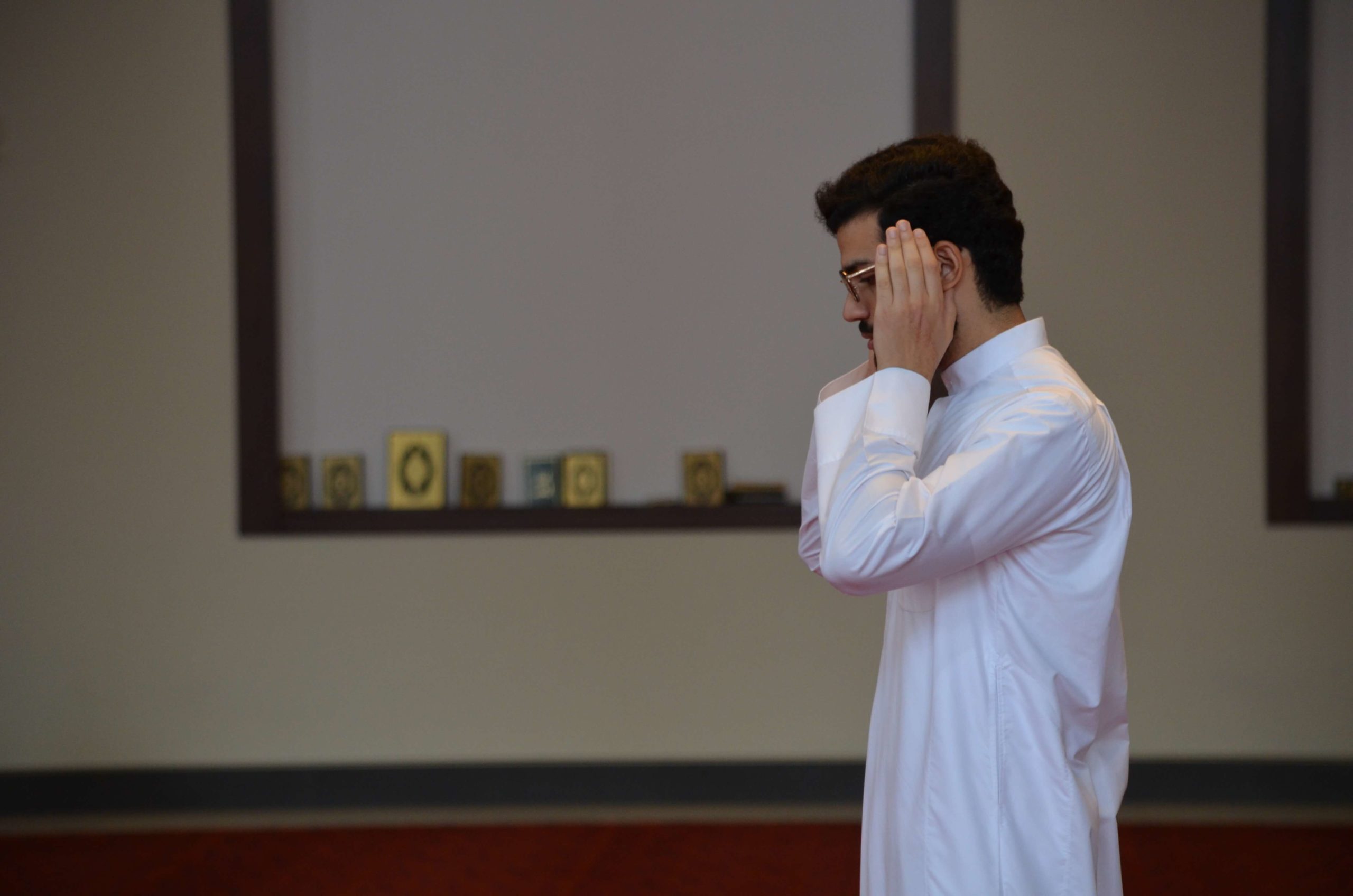
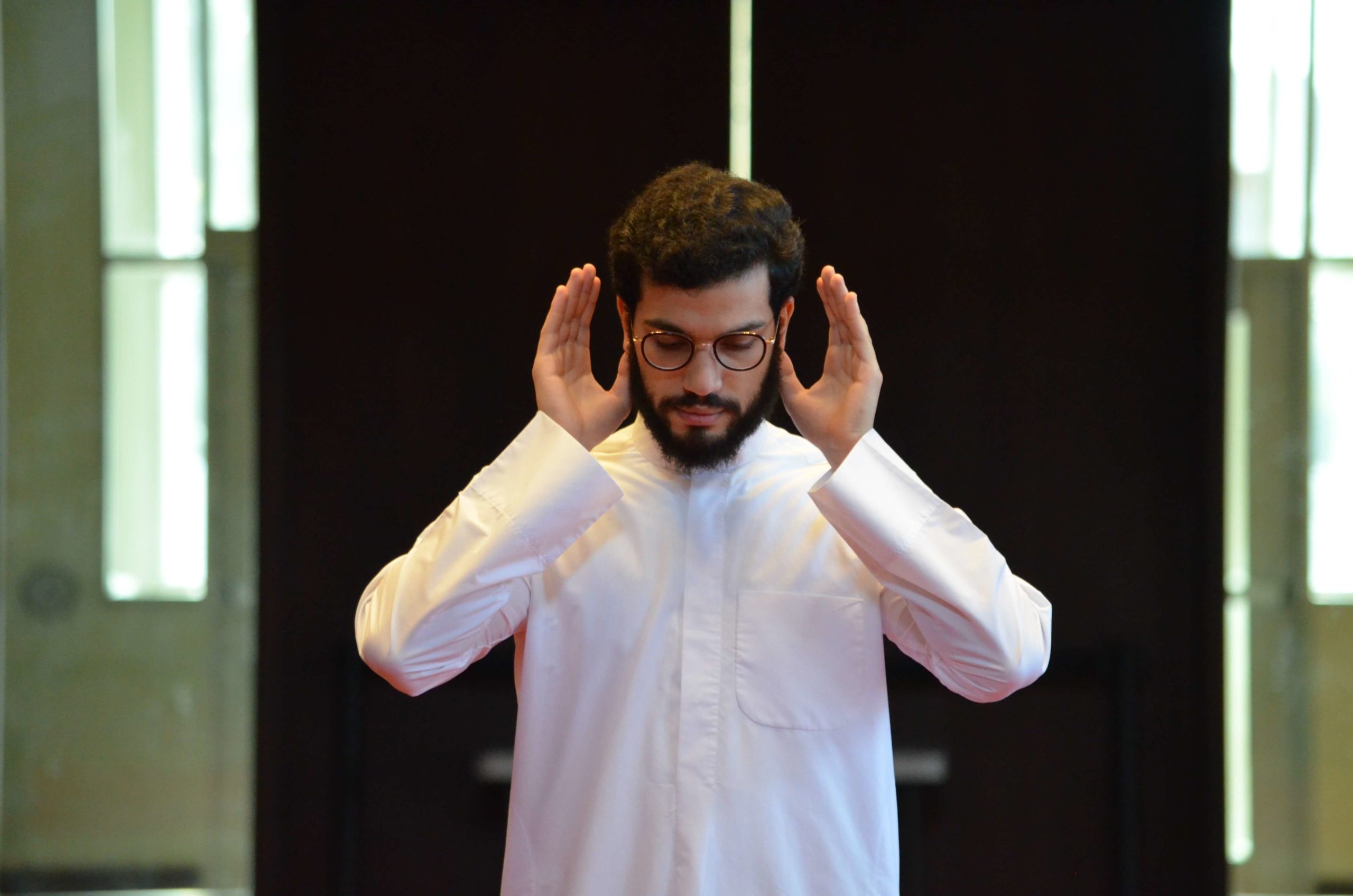
Lift your hands up to the level of your ears and proclaim, “Allahu Akbar” (God is the Greatest).
Step 3 – Positioning Hands and Beginning with Al-Isti’adhah
Gently place both hands on your chest, ensuring your right hand is above your left. Begin your prayer with the protective seeking phrase:
أَعُوذُ بِاللهِ مِنَ الشَّيْطَانِ الرَّجِيمِ
‘I seek refuge in Allah from the accursed Shaytan (devil).’
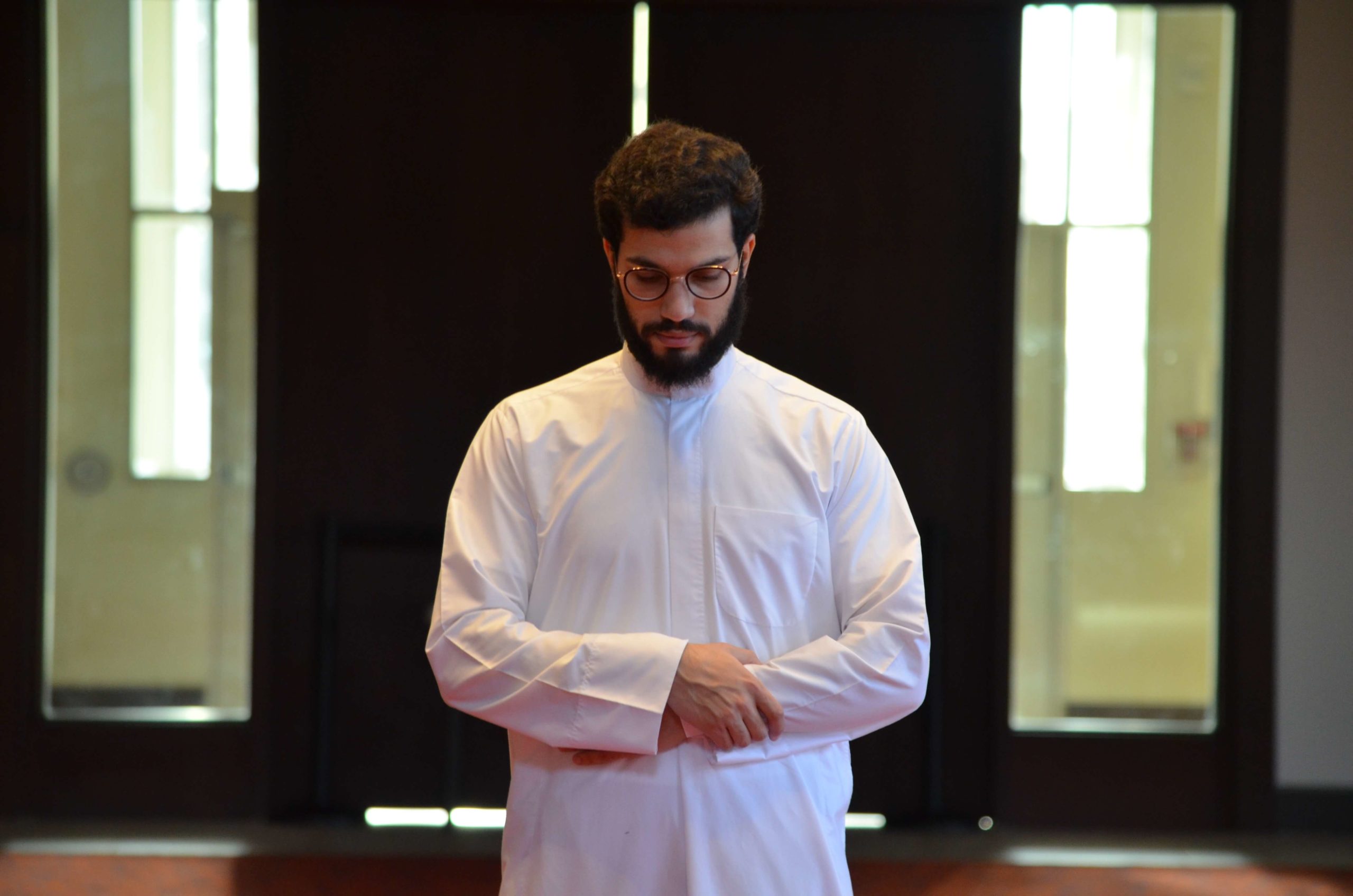
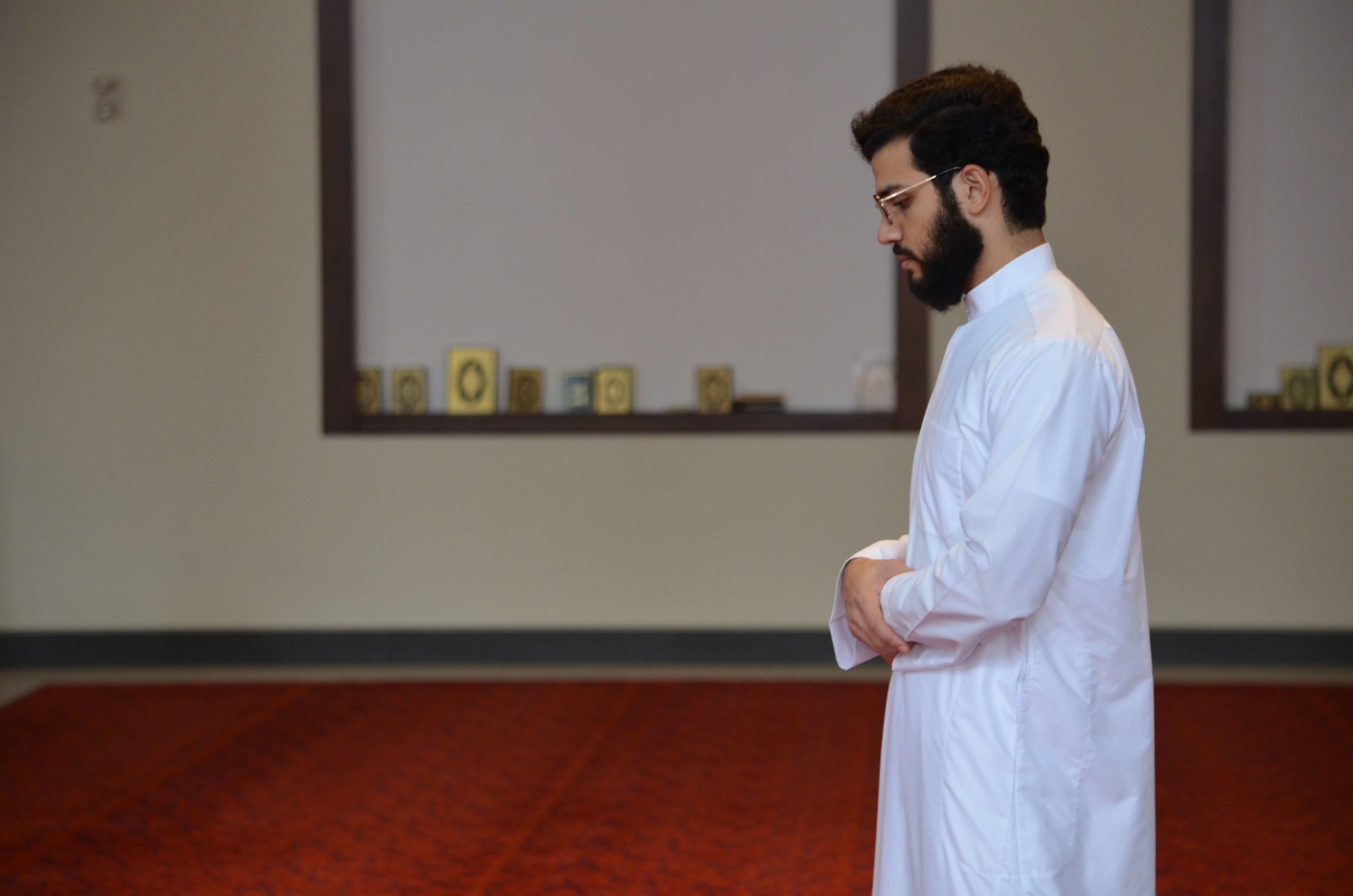
Step 4 – Recite the Opening Chapter (Surah Al-Fatihah)
Proceed with the recitation of Surah Al-Fatihah:
بِسْمِ اللَّـهِ الرَّحْمَـٰنِ الرَّحِيمِ ﴿١﴾ الْحَمْدُ لِلَّـهِ رَبِّ الْعَالَمِينَ ﴿٢﴾ الرَّحْمَـٰنِ الرَّحِيمِ ﴿٣﴾ مَالِكِ يَوْمِ الدِّينِ ﴿٤﴾ إِيَّاكَ نَعْبُدُ وَإِيَّاكَ نَسْتَعِينُ ﴿٥﴾ اهْدِنَا الصِّرَاطَ الْمُسْتَقِيمَ ﴿٦﴾ صِرَاطَ الَّذِينَ أَنْعَمْتَ عَلَيْهِمْ غَيْرِ الْمَغْضُوبِ عَلَيْهِمْ وَلَا الضَّالِّينَ
Translation of the surah al Fatiha:
1. In the name of Allah, the Entirely Merciful, the Especially Merciful.
2. [All] praise is [due] to Allah, Lord of the worlds.
3. The Entirely Merciful, the Especially Merciful.
4. Sovereign of the Day of Recompense.
5. It is You we worship and You we ask for help.
6. Guide us to the straight path.
7. The path of those upon whom You have bestowed favor, not of those who have evoked [Your] anger or of those who are astray.
This chapter, also known as the “Opening,” is a central part of every unit of Muslim prayer. Ensure clarity and sincerity in your recitation, understanding its meaning and significance in the prayer.
Step 5– Bowing in Reverence (Ruku)
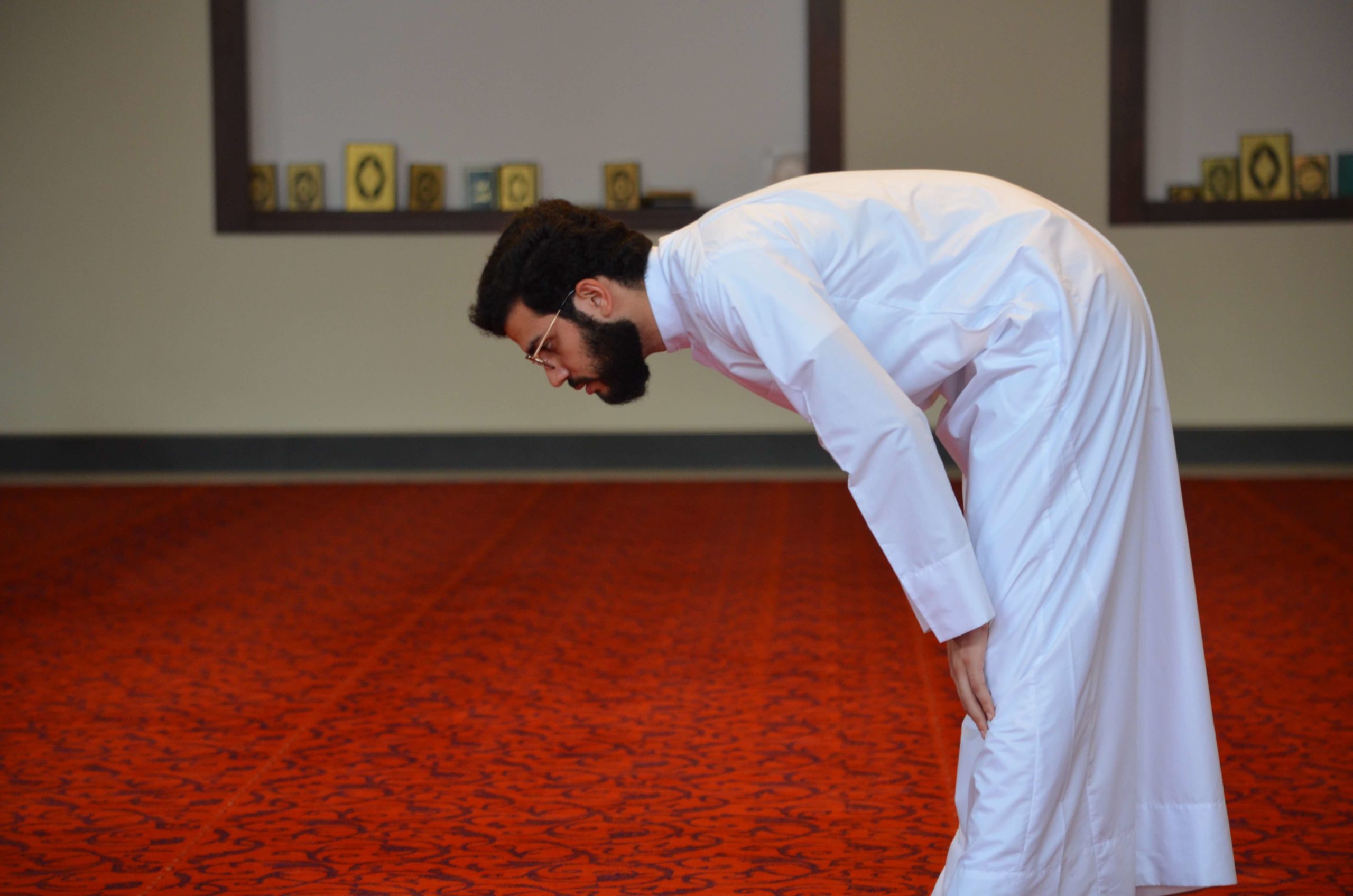

As you bow down, intone “Allahu Akbar” (Allah is the Greatest). Ensure your back is level and hands are placed on your knees, fingers spread out. Maintain a gaze toward the spot where you will later prostrate. In this posture of humility and reverence, repeat the following Arabic phrase three times:

Translation: ‘How perfect is my Lord, the Magnificent.’
Step 6– Resume a standing position
After completing the recitation, gently rise back to an upright standing position. As you lift yourself from the ‘Ruku’ stance, raise both hands to the level of your ears while saying:

Translation: ‘Allah hears those who praise him, Our Lord, to You is all praise.’
Step 7– Prostrating (Sujud)
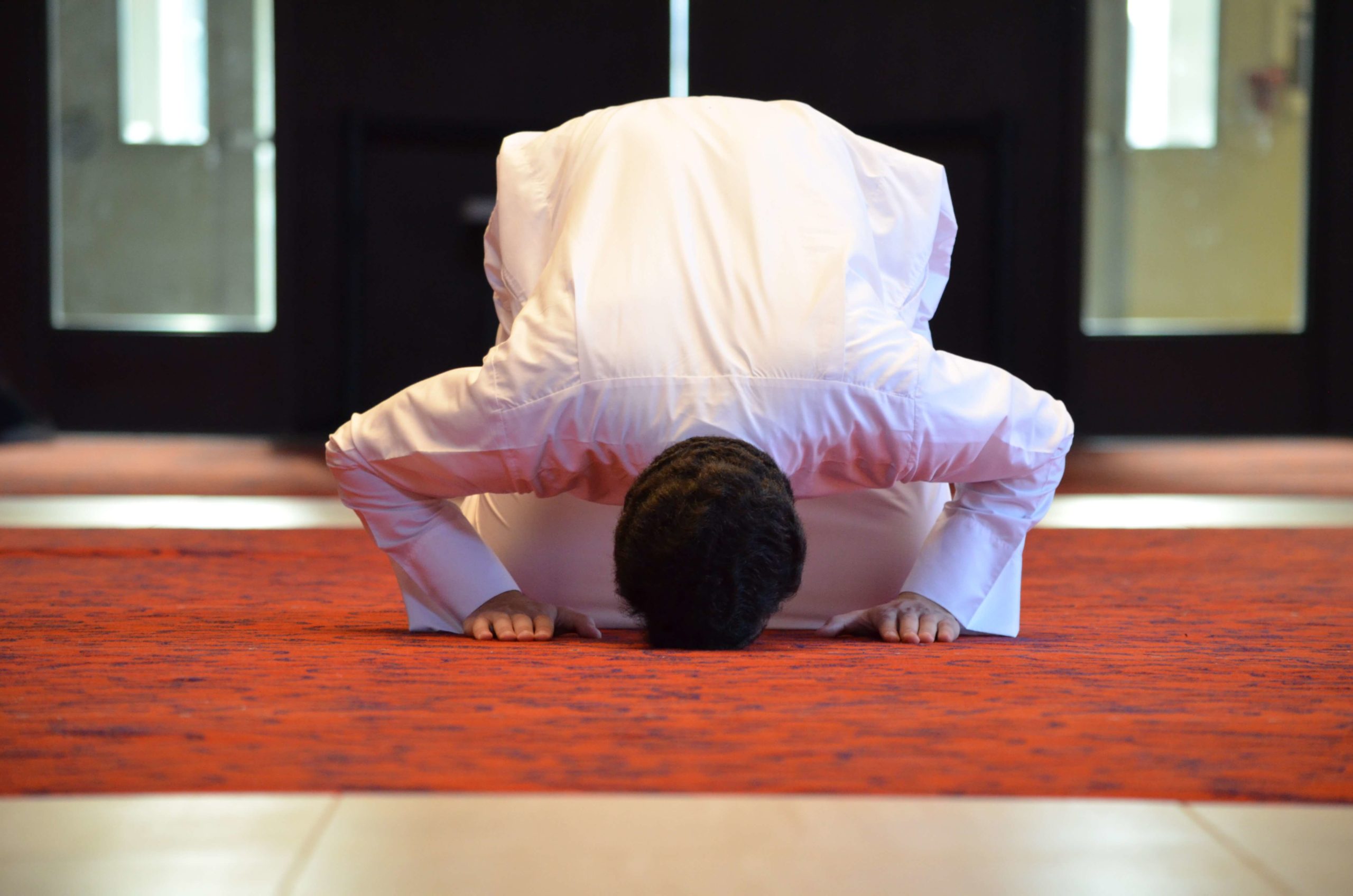
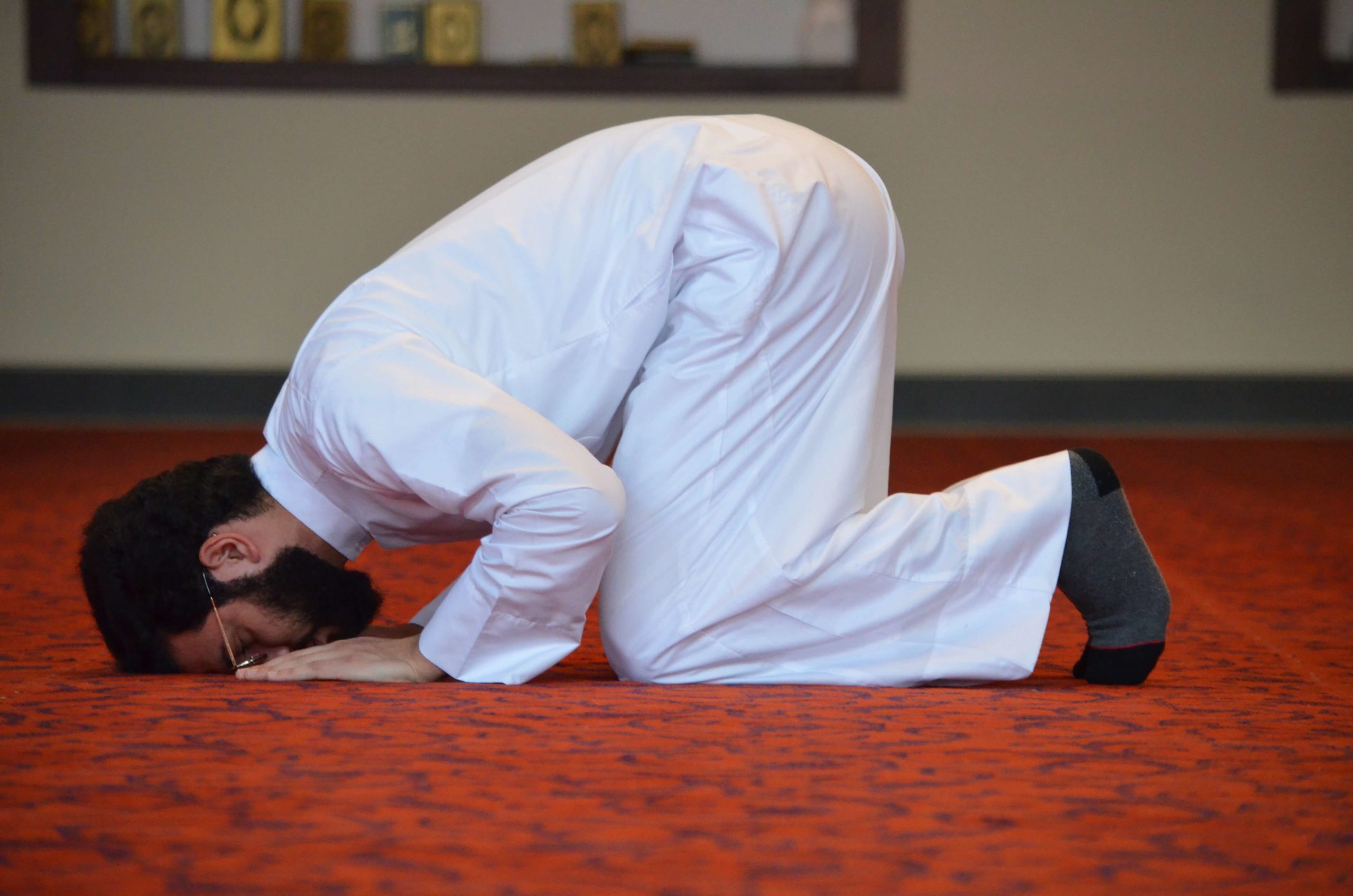

While lowering yourself into prostration, recite ‘Allahu Akbar.’ Ensure your palms, forehead, nose, knees, both hands, and toes are firmly pressed against the ground. During this moment of deep reverence, repeat the following phrase three times:
While prostrating to the ground, say ‘Allahu Akba.’. In this position, your palms, forehead, nose, knees, both hands, and toes should touch the ground. While in Sujud, recite this phrase 3 times:

Translation:‘ How perfect is my Lord, the highest.’
Step 8 – Taking a Moment to Sit
Upon lifting yourself from the first Sujud, say ‘Allahu Akbar’ and settle momentarily onto your left leg. Ensure your left foot is flat on the ground, while your right foot remains upright. For the second Sujud, revisit Step 5, ensuring you recite ‘Subhanna Rabbeeyal ‘Alaa’ three times once more.
Once the second prostration is done, rise to your standing position, echoing ‘Allahu Akbar.’
Congratulations! You’ve now successfully completed one rakah.
Bear in mind, these steps define the first rakah in every prayer. Additionally, at the conclusion of every second rakah, the tashahud should be performed.
Step 9: Seated Recitation (Tashahud)

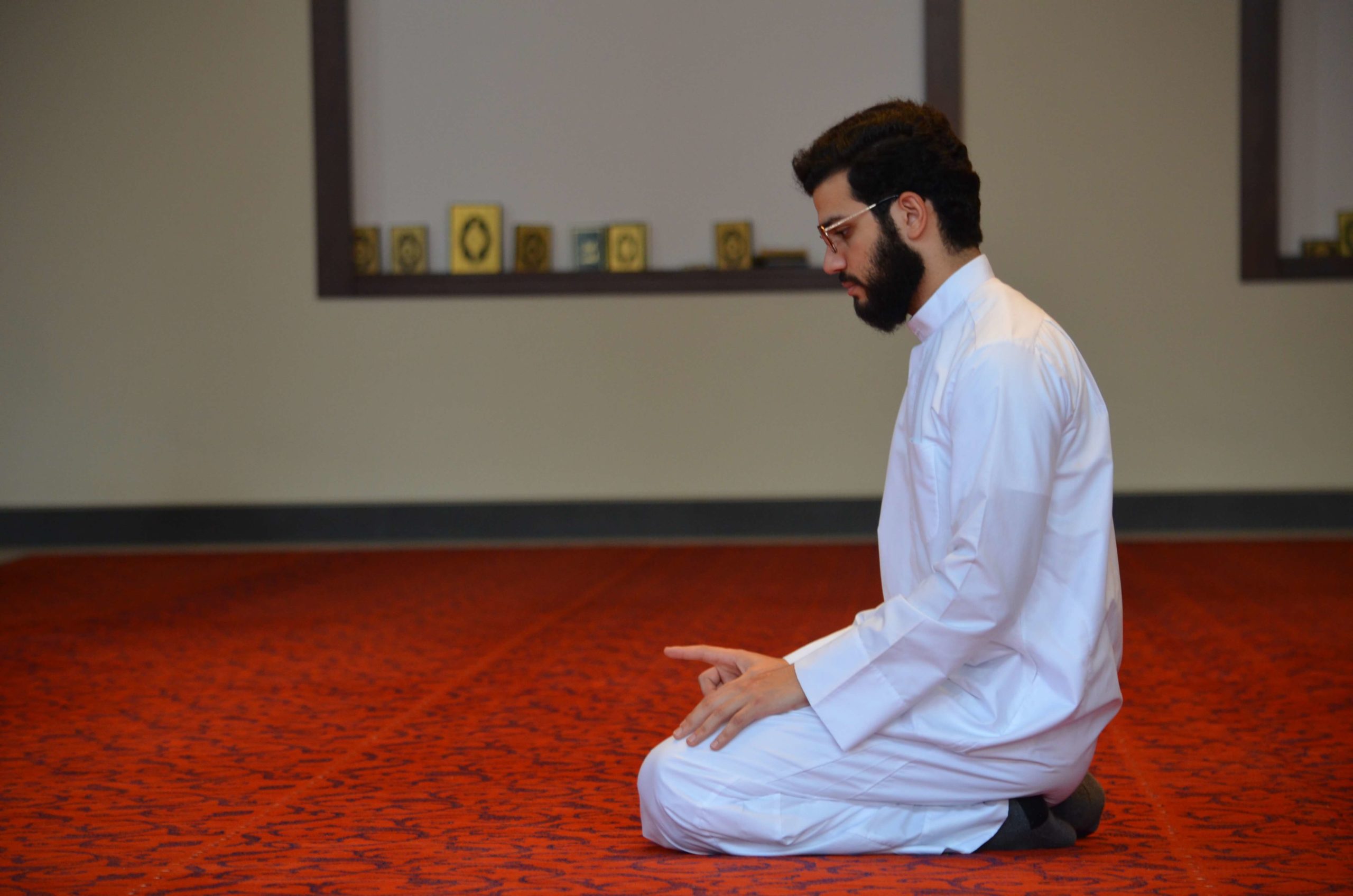
After completing every two rakats, you transition to the seated position following the second Sujud. In this position, you will recite the ‘Attahiyat,’ a significant supplication in Arabic that encapsulates a conversation between Allah and Prophet Muhammad (Peace Be Upon Him).
While reciting, gently raise the index finger of your right hand and say:
التحيات لله والصلوات والطيبات، السلام عليك أيها النبي ورحمة الله وبركاته، السلام علينا وعلى عباد الله الصالحين، أشهد أن لا إله إلا الله وحده لا شريك له، وأشهد أن محمدًا رسول الله
Translation:
‘All compliments, prayers, and pure words are due to Allah. Peace be upon you, O Prophet, and the mercy of Allah and His blessings. Peace be upon us, and on the righteous slaves of Allah. I bear witness that none has the right to be worshipped except Allah, and I bear witness that Muhammad is His slave and Messenger.’
After completing two rakats and the associated sujud, you will transition to a seated position to recite the ‘Attahiyat.’ This supplication in Arabic encapsulates a profound conversation between Allah and Prophet Muhammad (Peace Be Upon Him).
As you recite, gently lift the index finger of your right hand.
Additionally, at the conclusion of your prayer’s final rakah, following the tashahud, you should proceed to recite the ‘final tashahud.’
اللهم صل على محمد وعلى آل محمد كما صليت على إبراهيم وعلى آل إبراهيم في العالمين إنك حميد مجيد، و بارك على محمد وعلى آل محمد كما باركت على إبراهيم وعلى آل إبراهيم في العالمين إنك حميد مجيد
Translation:
‘O Allah, send prayers upon Muhammad and upon the family (or followers) of Muhammad, Just as You sent prayers upon Ibrahim and the family (or followers) of Ibrahim, Verily, you are full of Praise and Majesty. O Allah, bless Muhammad and the family (or followers) of Muhammad as You blessed Ibrahim and the family (or followers) of Ibrahim, Verily, you are full of Praise and Majesty.’



While moving into prostration, recite ‘Allahu Akbar.’ Ensure that in this position, your palms, forehead, nose, knees, and toes are firmly touching the ground. During this Sujud, repeat the following phrase three times:

Translation:
‘How perfect is my Lord, the highest.’
How to finish the prayer?

Upon concluding all the Rakat of the prayer, finalize your Salah. Turn your face to the right and recite:
السلام عليكم و رحمة الله
Translation: May the peace and mercy of Allah be with you
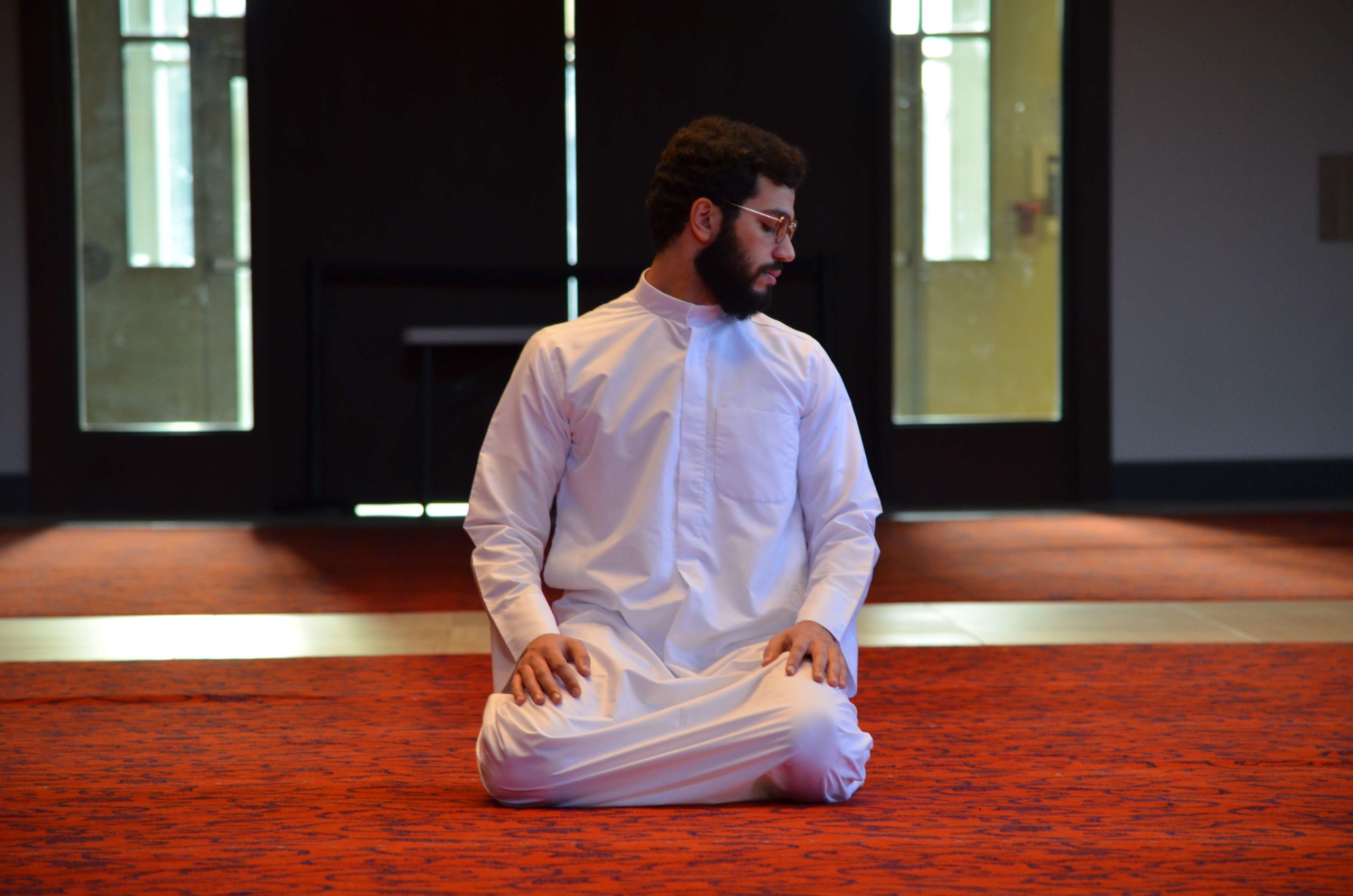
How many Rakat are performed in Arabic prayers?
The five daily prayers in Islam each consist of a specific number of Rakat:
- Fajr prayer (Pre-dawn): 2 Rakat
- Duhur prayer (Mid-day): 4 Rakat
- Asr prayer (Afternoon): 4 Rakat
- Maghreb prayer (Sunset): 3 Rakat
- Isha prayer (Night): 4 Rakat
Notably:
- For both Duhur and Asr prayers, the recitation of Al-Fatiha and any subsequent Surah is silent.
- During the Fajr prayer, recite Al-Fatiha followed by another Surah aloud.
- For the Maghreb and Isha prayers, the recitation of Al-Fatiha and the subsequent Surah should be done aloud for the first 2 Rakat.
It’s recommended to recite a Surah or some verses from the Quran after Al-Fatiha during the first two Rakat of each prayer.
With an understanding of how to perform a single Rakat in Arabic, you can now complete the entire prayer sequence by repeating the necessary steps for each of the five daily prayers.
Chosen and Trusted by Thousands of Satisfied Learners
Discover the experiences of our delighted clients who have thoroughly enjoyed utilizing this standout feature.
Alhamdulillah I‘m very pleased with the arabic and Qur’an lessons I receive from teacher Umm Tasneem and I‘m also content with the al-dirassa administration team who were very quick in answering any questions I had. In a month I progressed a lot and I cannot wait to continue my studies with al-dirassa. May Allah reward everyone at al-dirassa.
 Verified review - view original
Verified review - view original
My Qur’an teacher is fantastic, she teaches me in a loving and kind way where I look forward to the lessons and learn so much. My Arabic teacher is equally as nice and has a lot of patience with me, she has great expertise in the field and I’ve progressed really quickly with her. Thank you Al-dirassa!
 Verified review - view original
Verified review - view original
Book your free trial lesson
Don’t want to go through the translation anymore?
30 free minutes with your qualified Egyptian teacher.




